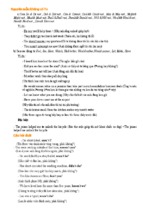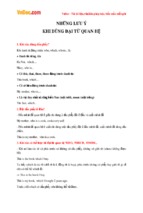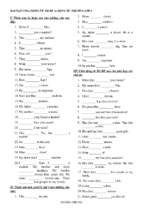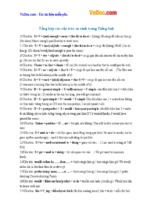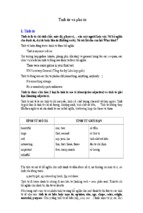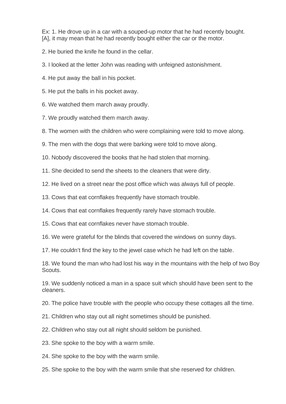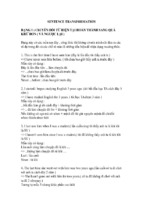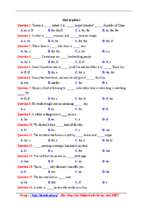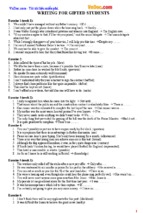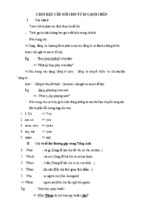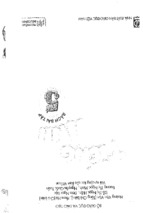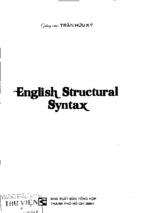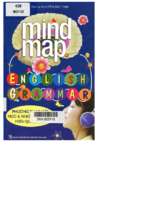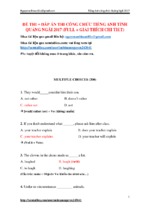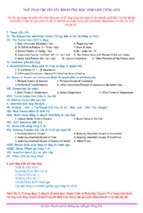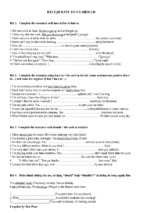Word Power: Phrasal Verbs and Compounds
≥
Planet Communication
Editors
Angeliki Athanasiadou
Christa van der Walt
Mouton de Gruyter
Berlin · New York
Word Power:
Phrasal Verbs and Compounds
A Cognitive Approach
by
Brygida Rudzka-Ostyn
Mouton de Gruyter
Berlin · New York 2003
Mouton de Gruyter (formerly Mouton, The Hague)
is a Division of Walter de Gruyter GmbH & Co. KG, Berlin.
앝 Printed on acid-free paper which falls within the guidelines
앪
of the ANSI to ensure permanence and durability.
ISBN 3-11-017703-X hb
ISBN 3-11-017704-8 pb
Bibliographic information published by Die Deutsche Bibliothek
Die Deutsche Bibliothek lists this publication in the Deutsche
Nationalbibliografie; detailed bibliographic data is available in the
Internet at ⬍http://dnb.ddb.de⬎.
” Copyright 2003 by Walter de Gruyter GmbH & Co. KG, 10785 Berlin
All rights reserved, including those of translation into foreign languages. No part of this
book may be reproduced or transmitted in any form or by any means, electronic or mechanical, including photocopy, recording, or any information storage and retrieval system, without permission in writing from the publisher.
Cover design: Sigurd Wendland, Berlin.
Printed in Germany.
Preface
Word Power: Phrasal Verbs and Compounds, a Cognitive Approach is a textbook for guided self-learning intended for post-intermediate and advanced students of English.
The textbook contains some 1,100 phrasal verbs and compounds used with
17 particles and/or prepositions which combine with some 500 different verbs,
nouns or adjectives. The book deals in the first place with the major problems
encountered by even advanced students, viz. understanding and mastering the
metaphorical meanings of the particles and the phrasal verbs as a whole. Secondly, depending on the students’ level of competence, the book confronts
them with another 2,500 to 3,000 less frequently used words in the sentences,
explanations, collocations and glosses in connection with the phrasal verbs and
compounds. These words constitute an equally essential part of the book and
need to be mastered to the same extent as the phrasal material itself.
Expanding students’ word power efficiently
In order to help more advanced grown-up learners to rapidly and significantly
expand their lexicon, the basis of accurate and fluent communication, we have
implemented some of the major findings from both cognitive and applied linguistics.
First, the phrasal verbs and compounds are grouped around each particle.
This particle-based arrangement reveals the networks of related meanings of
the particles. As experiments have shown, this fascinating insight-oriented approach – visually enhanced by intentionally abstract drawings – enables and
encourages the students to create their own contextual schemata, which all contribute to learning the metaphorical extensions faster, better, and above all, in a
much more gratifying way.
Second, this textbook implements a battery of techniques used in applied linguistics to develop intensively the students’ vocabulary in artificial school settings. It has been shown experimentally that learners fix new words or new
meanings in a foreign language best:
– if they are systematically and explicitly focused upon;
– if they are embedded in contexts;
– if they are hooked up with other words they often co-occur with (collocations);
– if learners write them out;
vi
Preface
– if there are opportunities to guess their meanings (cf. infra);
– if contexts, glosses, explanations make target words or meanings readily accessible reducing to a minimum wild guessing and/or time-consuming dictionary searches – however useful the latter may sometimes be;
– if their presentation in exetests (EXErcises + TESTS) allows for reviewing
them as often as needed;
– if they are activated orally (through learner-centred or horizontal class activities in pairs).
In this guided self-learning approach, teachers play more than ever a crucial
role. As true managers they divide the material into weekly portions, organize
and supervize the horizontal classroom work, help the students gain (cognitive)
insights into the related meanings of the particles or into knowledge they can
not easily acquire by themselves. Finally they provide students with feedback
through tests.
How this textbook could be used
Methodological suggestions are always welcome but should never be taken as
a must. Teachers or students should therefore consider the suggestions below
only as a source of inspiration to add to their own experience.
The introductory chapter
The introductory chapter provides only the essential syntactic and semantic information necessary to understand what phrasal verbs and compounds are
about. Even in this basic chapter there might be little classical teaching since
this book is essentially written for guided self-learning. The questions at the
end of the introductory chapter could therefore also be handled horizontally (in
pairs or small groups).
1 Preliminary individual work (preferably outside the classroom)
As classroom time is generally very limited and since the book is written for
post-intermediate or advanced learners, students might be asked to do all lowlevel work (cf. infra) individually before coming to class.
They can access the missing phrasal elements and their meanings in three
ways: (1) the first letter(s) of each verb/noun/adjective is indicated to the right
of each sentence, (2) the verbs/nouns to be filled in are also alphabetically arranged on top of each exetest (EXErcise + TEST), and (3) in the key at the end
of a section. Glosses at the bottom of each exetest explain less frequently used
words in the sentential contexts.
Learners might proceed along the following lines:
1 they guess the verbs/nouns to be filled in, check to see if their guesses are
correct and complete the initial letters or clusters in the spaces to the right of
the sentences;
2 they consult the glosses for words they do not know or are not sure of;
3 they read (preferably aloud) the sentences while looking also at the verbs/
compounds;
4 they cover up the verbs/compounds and read the sentences (while completing the dotted spaces); they may want to do this reading several times until
they attain natural fluency;
viii
How this textbook could be used
5 they change the order in which they read the sentences: first from top to bottom, then the other way round or at random;
6 they tick off the sentences where their reading and completing is least fluent;
7 they cover up the sentences and this time use the verbs as starters for identical/similar/totally different sentences or contexts in which the verbs fit.
N.B. Time being money, they focus on the sentences over which they hesitate.
2 Classroom work
Classroom activities could consist of two types of interaction: one horizontal,
i.e. in pairs, and one vertical, i.e. teacher-students.
2.1 Simultaneous ‘student – student’ work (in pairs or in small groups)
Oral horizontal class activities could consist of working in pairs/small groups
of students in which the learners take turns, and choose from the following activities:
1 they define, paraphrase, explain (in their own words or through examples/
synonyms) any words (and not only verbs) any one of the (two or more)
members finds difficult;
They can also start from some of the glosses to find the words related to them.
2 they cover up the verbs (filled in previously to the right) and read (some of)
the sentences aloud; take turns to tell the other person which sentence (s)he
has to read and complete;
3 they cover up the sentences and start from the verbs to the right creating similar or different sentences in which the verbs fit;
4 they explain how the verbs specify different ways of moving: fly, jump, send,
spring, walk, etc.;
5 they identify in some of the sentences the different trajectors/entities (that
exemplify a certain movement) or the landmarks/containers;
6 they show which particles have spatial meanings and which ones have metaphorical meanings;
7 they indicate in which sentences the particle follows the direct object;
8 they pick out the sentences in which the landmarks (points/containers/surfaces) are not specified;
9 they drop the landmark (point/container/surface) where it is mentioned and
add one where it is not specified.
3 Conclusion
ix
P.S. Activities 5 to 9 might rather be done under the teacher’s supervision.
One should not overkill by doing too many analyses, however. The quantity
of material covered is as important as the quality of the knowledge acquired.
As an expert-manager, the teacher is best placed to decide which tasks
should be done only occasionally or not at all.
2.2 Teacher – students interaction (either in pairs or in small groups)
As suggested above, the more difficult some of the above activities are, the
more the teacher-manager might turn to vertical interaction. One activity in
which (s)he should play a leading role is in helping the students discover which
semantic features are conveyed by the particle or by the phrasal verb as a
whole.
3 Conclusion
Again, it may be stressed that the purpose of this book is to expand massively
and qualitatively the students’ vocabulary in general and that of phrasal verbs/
compounds in particular. This is therefore not a textbook on (some aspects of)
cognitive linguistics though it also uses its insights as a means to achieve this
lexical goal.
Acknowledgements
This pedagogical textbook with a filtered and simplified cognitive analysis of
phrasal verbs and compounds is Brygida Rudzka’s work. As a result of her untimely death she was unable to finish it.
Since at least two decades have evolved since the analyses of the most salient
features of phrasal verbs/compounds were published in doctoral dissertations, I
am very much indebted to René Dirven, who went through different versions of
this textbook meticulously, updating and refining the linguistic analyses while
adding numerous valuable methodological comments and suggestions which
have greatly improved this textbook.
I am also very grateful to Gene Casad, Stefan Gries, Vincent Lobet, Michael
Taylor and Irena Wierzbicka for providing additional information, corrections
and suggestions.
A special word of thanks goes to Lukasz Tabakowski and Yves Mine, who
drew the schemata; to Elzbieta Tabakowska, Andrzej Kurtyka, Angeliki Athanasiadou and their colleagues and former high school students and teachers in
Krakow and Thessaloniki for experimenting with parts of the manuscript and
providing us with precious feedback.
I also owe a particular debt of gratitude to Jane Oehlert and Peter Kelly for
sharing with us their native-speaker intuitions as well as to the many native
speakers who thought up the sentences illustrating different metaphorical
meanings of the phrasal verbs and compounds.
April 2003
Paul Ostyn
Table of contents
Preface . . . . . . . . . . . . . . . . . . . . . . . . . . . . . . . . . . . . . . . . . . . . . . . . . . . . . . . . . . . . . . .
How this textbook could be used . . . . . . . . . . . . . . . . . . . . . . . . . . . . . . . . . . . . .
Acknowledgements . . . . . . . . . . . . . . . . . . . . . . . . . . . . . . . . . . . . . . . . . . . . . . . . . .
v
vii
x
Introduction: Words and the World . . . . . . . . . . . . . . . . . . . . . . . . . . . . . . . .
1
1
2
2
3
1
2
2.1
2.2
2.3
2.4
3
4
4.1
4.2
4.3
The syntactic frames of phrasal verbs . . . . . . . . . . . . . . . . . . . . . . . . . .
The meaning of phrasal verbs . . . . . . . . . . . . . . . . . . . . . . . . . . . . . . . . . .
The meaning of the verb . . . . . . . . . . . . . . . . . . . . . . . . . . . . . . . . . . . . . . .
The meaning of the particles . . . . . . . . . . . . . . . . . . . . . . . . . . . . . . . . . . .
The metaphorical meaning of the whole expression
‘verb + particle’ . . . . . . . . . . . . . . . . . . . . . . . . . . . . . . . . . . . . . . . . . . . . . . .
A phrasal verb with one particle often has several meanings . .
What do we use language for? . . . . . . . . . . . . . . . . . . . . . . . . . . . . . . . . .
How do we perceive and conceive reality? . . . . . . . . . . . . . . . . . . . . .
The trajector and landmark: the moving entity and the place
(point, container, surface) where it moves . . . . . . . . . . . . . . . . . . . . .
Symbols used in the drawings . . . . . . . . . . . . . . . . . . . . . . . . . . . . . . . . .
Questions on the Introduction . . . . . . . . . . . . . . . . . . . . . . . . . . . . . . . . . .
1 OUT is leaving a container . . . . . . . . . . . . . . . . . . . . . . . . . . . . . . . . . . . . . .
1.1
1.2
1.3
1.4
1.5
1.6
OUT: entities moving out of containers . . . . . . . . . . . . . . . . . . . . . . . .
OUT: eat or inviting to eat away from home . . . . . . . . . . . . . . . . . . .
OUT: sets, groups are containers . . . . . . . . . . . . . . . . . . . . . . . . . . . . . . .
OUT: bodies, minds, mouths are viewed as containers . . . . . . . .
OUT: states/situations are containers . . . . . . . . . . . . . . . . . . . . . . . . . .
OUT: non-existence, ignorance, invisibility also function as
containers . . . . . . . . . . . . . . . . . . . . . . . . . . . . . . . . . . . . . . . . . . . . . . . . . . . . . .
1.7 OUT: trajectors increasing to maximal boundaries . . . . . . . . . . . .
1.8 OUT: key . . . . . . . . . . . . . . . . . . . . . . . . . . . . . . . . . . . . . . . . . . . . . . . . . . . . . . .
1.9 Expand and test your knowledge of ‘out’ . . . . . . . . . . . . . . . . . . . . . .
1.10 Key to ‘Expand and test your knowledge of ‘out’’ . . . . . . . . . . . .
2 IN is entering or being inside a container . . . . . . . . . . . . . . . . . . . . .
2.1
2.2
2.3
2.4
2.5
IN: being inside or entering a container . . . . . . . . . . . . . . . . . . . . . . . .
IN: atmospheric circumstances as containers . . . . . . . . . . . . . . . . . .
IN: time viewed as a container . . . . . . . . . . . . . . . . . . . . . . . . . . . . . . . . .
IN: sets or groups viewed as containers . . . . . . . . . . . . . . . . . . . . . . . .
IN: situations, circumstances as containers . . . . . . . . . . . . . . . . . . . .
5
5
6
8
9
11
12
14
14
18
19
20
22
25
32
34
37
41
48
48
51
52
55
55
xii
Table of contents
2.6
2.7
2.8
2.9
IN: psychological, physical states viewed as containers . . . . . . .
IN: key . . . . . . . . . . . . . . . . . . . . . . . . . . . . . . . . . . . . . . . . . . . . . . . . . . . . . . . . .
Expand and test your knowledge of ‘in’ . . . . . . . . . . . . . . . . . . . . . . .
Key to ‘Expand and test your knowledge of ‘in’’ . . . . . . . . . . . . .
57
60
62
65
3 INTO is entering a container . . . . . . . . . . . . . . . . . . . . . . . . . . . . . . . . . . .
69
69
70
72
72
73
3.1
3.2
3.3
3.4
3.5
INTO: motion into a container . . . . . . . . . . . . . . . . . . . . . . . . . . . . . . . . .
INTO: change is motion from one state into another . . . . . . . . . .
INTO: key . . . . . . . . . . . . . . . . . . . . . . . . . . . . . . . . . . . . . . . . . . . . . . . . . . . . . .
Expand and test your knowledge of ‘into’ . . . . . . . . . . . . . . . . . . . . .
Key to ‘Expand and test your knowledge of ‘into’’ . . . . . . . . . . .
4 UP is positive verticality . . . . . . . . . . . . . . . . . . . . . . . . . . . . . . . . . . . . . . . . .
4.1
4.2
4.3
4.4
4.5
4.6
4.7
4.8
UP: position at a high place or moving up to a higher one . . . .
UP (to): aiming at or reaching a goal, an end, a limit . . . . . . . . . .
UP: moving to a higher degree, value or measure . . . . . . . . . . . . .
UP: higher up is more visible, accessible, known . . . . . . . . . . . . . .
UP: covering an area completely/reaching the highest limit . . .
UP: Key . . . . . . . . . . . . . . . . . . . . . . . . . . . . . . . . . . . . . . . . . . . . . . . . . . . . . . . .
Expand and test your knowledge of ‘up’ . . . . . . . . . . . . . . . . . . . . . . .
Key to ‘Expand and test your knowledge of ‘up’’ . . . . . . . . . . . . .
75
75
77
80
85
86
89
92
97
5 DOWN is negative verticality . . . . . . . . . . . . . . . . . . . . . . . . . . . . . . . . . . . 104
5.1
5.2
5.3
5.4
5.5
5.6
5.7
5.8
DOWN: movement from a higher to a lower place . . . . . . . . . . . .
DOWN: time and geographically orientated motion . . . . . . . . . . .
DOWN: decrease in intensity, quality, quantity, size, degree,
value, activity, status, strength ... . . . . . . . . . . . . . . . . . . . . . . . . . . . . . . .
DOWN: reach a goal, completion, extreme limit down the
scale . . . . . . . . . . . . . . . . . . . . . . . . . . . . . . . . . . . . . . . . . . . . . . . . . . . . . . . . . . . .
DOWN: movements of eating or writing . . . . . . . . . . . . . . . . . . . . . .
DOWN: key . . . . . . . . . . . . . . . . . . . . . . . . . . . . . . . . . . . . . . . . . . . . . . . . . . . .
Expand and test your knowledge of ‘down’ . . . . . . . . . . . . . . . . . . .
Key to ‘Expand and test your knowledge of ‘down’’ . . . . . . . . . .
104
106
107
111
112
113
115
118
6 OFF is breaking contact . . . . . . . . . . . . . . . . . . . . . . . . . . . . . . . . . . . . . . . . . 121
6.1
6.2
6.3
6.4
6.5
OFF: loss of spatial contact or spatial separation . . . . . . . . . . . . . .
OFF: separation as loss of contact . . . . . . . . . . . . . . . . . . . . . . . . . . . . .
OFF: separation as interruption of flow/supply . . . . . . . . . . . . . . . .
OFF: separation due to motion away from its former state,
condition or point of reference . . . . . . . . . . . . . . . . . . . . . . . . . . . . . . . . .
OFF: key . . . . . . . . . . . . . . . . . . . . . . . . . . . . . . . . . . . . . . . . . . . . . . . . . . . . . . .
121
123
125
126
132
Table of contents
6.6
6.7
xiii
Expand and test your knowledge of ‘off’ . . . . . . . . . . . . . . . . . . . . . . 133
Key to ‘Expand and test your knowledge of ‘off’’ . . . . . . . . . . . . 137
7 AWAY is disappearing . . . . . . . . . . . . . . . . . . . . . . . . . . . . . . . . . . . . . . . . . . . 139
7.1
7.2
7.3
7.4
7.5
7.6
AWAY: leaving a place or not being at it . . . . . . . . . . . . . . . . . . . . . . .
AWAY: gradual and continuously growing distance . . . . . . . . . . .
AWAY: complete disappearance . . . . . . . . . . . . . . . . . . . . . . . . . . . . . . .
AWAY: key . . . . . . . . . . . . . . . . . . . . . . . . . . . . . . . . . . . . . . . . . . . . . . . . . . . . .
Expand and test your knowledge of ‘away’ . . . . . . . . . . . . . . . . . . . .
Key to ‘Expand and test your knowledge of ‘away’’ . . . . . . . . . .
139
141
143
144
145
147
8 ON is contact . . . . . . . . . . . . . . . . . . . . . . . . . . . . . . . . . . . . . . . . . . . . . . . . . . . . . . 149
8.1
8.2
8.3
8.4
8.5
8.6
8.7
8.8
ON: contact or getting closer to make contact . . . . . . . . . . . . . . . . .
ON: from contact to closeness . . . . . . . . . . . . . . . . . . . . . . . . . . . . . . . . .
ON: time viewed as a surface . . . . . . . . . . . . . . . . . . . . . . . . . . . . . . . . . .
ON: continuation of an action or situation . . . . . . . . . . . . . . . . . . . . .
ON: cause – effect viewed as two entities in contact . . . . . . . . . . .
ON: key . . . . . . . . . . . . . . . . . . . . . . . . . . . . . . . . . . . . . . . . . . . . . . . . . . . . . . . .
Expand and test your knowledge of ‘on’ . . . . . . . . . . . . . . . . . . . . . . .
Key to ‘Expand and test your knowledge of ‘on’’ . . . . . . . . . . . . .
149
151
152
153
154
156
156
158
9 OVER is higher than and close to . . . . . . . . . . . . . . . . . . . . . . . . . . . . . . 160
9.1
9.2
9.3
9.4
9.5
9.6
9.7
9.8
9.9
OVER: being or moving higher than and close to sth or from
one side to the other . . . . . . . . . . . . . . . . . . . . . . . . . . . . . . . . . . . . . . . . . . . .
OVER: crossing a certain distance to get closer . . . . . . . . . . . . . . .
OVER: Motion viewed as covering completely or even in
excess . . . . . . . . . . . . . . . . . . . . . . . . . . . . . . . . . . . . . . . . . . . . . . . . . . . . . . . . . .
OVER/UNDER: higher than/beyond or lower than/below the
norm . . . . . . . . . . . . . . . . . . . . . . . . . . . . . . . . . . . . . . . . . . . . . . . . . . . . . . . . . . . .
OVER: examining thoroughly from all sides . . . . . . . . . . . . . . . . . .
OVER: reflexive motion or completely bent . . . . . . . . . . . . . . . . . . .
OVER: key . . . . . . . . . . . . . . . . . . . . . . . . . . . . . . . . . . . . . . . . . . . . . . . . . . . . .
Expand and test your knowledge of ‘over(-)/under-’ . . . . . . . . . .
Key to ‘Expand and test your knowledge of ‘over(-)/under-’’ .
160
161
162
164
167
168
169
170
172
10 BACK is returning . . . . . . . . . . . . . . . . . . . . . . . . . . . . . . . . . . . . . . . . . . . . . . . . 173
10.1
10.2
10.3
10.4
10.5
BACK: return to or stay at an earlier location . . . . . . . . . . . . . . . . .
BACK: Return to an earlier state, time, situation . . . . . . . . . . . . . .
BACK: key . . . . . . . . . . . . . . . . . . . . . . . . . . . . . . . . . . . . . . . . . . . . . . . . . . . . .
Expand and test your knowledge of ‘back’ . . . . . . . . . . . . . . . . . . . .
Key to ‘Expand and test your knowledge of ‘back’’ . . . . . . . . . . .
173
174
177
178
179
xiv
Table of contents
11 ABOUT is dispersion . . . . . . . . . . . . . . . . . . . . . . . . . . . . . . . . . . . . . . . . . . . . . 180
11.1 ABOUT: location or motion in vicinity but in no particular
direction . . . . . . . . . . . . . . . . . . . . . . . . . . . . . . . . . . . . . . . . . . . . . . . . . . . . . . . .
11.2 ABOUT: from motion on a surface to mental motion on topics
11.3 ABOUT: from vicinity to proximity in size, time, measure,
quantity . . . . . . . . . . . . . . . . . . . . . . . . . . . . . . . . . . . . . . . . . . . . . . . . . . . . . . . .
11.4 ABOUT: key . . . . . . . . . . . . . . . . . . . . . . . . . . . . . . . . . . . . . . . . . . . . . . . . . . .
180
181
182
183
12 (A)ROUND is vicinity or circular motion . . . . . . . . . . . . . . . . . . . . 184
12.1 (A)ROUND: Location or motion (in different directions) often
viewed from a central point . . . . . . . . . . . . . . . . . . . . . . . . . . . . . . . . . . . . 184
12.2 (A)ROUND: figurative activities other than motion . . . . . . . . . . . 185
12.3 (A)ROUND: key . . . . . . . . . . . . . . . . . . . . . . . . . . . . . . . . . . . . . . . . . . . . . . . 186
13 ABOUT/(A)ROUND is dispersion vs. circular motion . . . . . 187
13.1 ABOUT/(A)ROUND: motion along +/– circular paths in
different directions . . . . . . . . . . . . . . . . . . . . . . . . . . . . . . . . . . . . . . . . . . . . .
13.2 ABOUT/(A)ROUND: (metaphorical) paths in all kinds of
directions . . . . . . . . . . . . . . . . . . . . . . . . . . . . . . . . . . . . . . . . . . . . . . . . . . . . . . .
13.3 ABOUT/(A)ROUND: key . . . . . . . . . . . . . . . . . . . . . . . . . . . . . . . . . . . . .
13.4 Expand and test your knowledge of ‘about/(a)round’ . . . . . . . . .
13.5 Key to ‘Expand and test your knowledge of ‘about/(a)round’’
187
189
190
190
192
14 ACROSS is motion to opposite side . . . . . . . . . . . . . . . . . . . . . . . . . . . 193
14.1 ACROSS (preposition): motion from one side of a surface to
another . . . . . . . . . . . . . . . . . . . . . . . . . . . . . . . . . . . . . . . . . . . . . . . . . . . . . . . . . 193
14.2 ACROSS (particle): figurative motion crossing to a human
receiver . . . . . . . . . . . . . . . . . . . . . . . . . . . . . . . . . . . . . . . . . . . . . . . . . . . . . . . . . 193
14.3 ACROSS: key . . . . . . . . . . . . . . . . . . . . . . . . . . . . . . . . . . . . . . . . . . . . . . . . . . 194
15 THROUGH is crossing a container . . . . . . . . . . . . . . . . . . . . . . . . . . . . 195
15.1
15.2
15.3
15.4
15.5
THROUGH: motion inside an entity from end to end . . . . . . . . .
THROUGH: activities viewed as complete(d) motions . . . . . . . .
THROUGH: key . . . . . . . . . . . . . . . . . . . . . . . . . . . . . . . . . . . . . . . . . . . . . . .
Expand and test your knowledge of ‘through’ . . . . . . . . . . . . . . . . .
Key to ‘Expand and test your knowledge of ‘through’’ . . . . . . .
195
195
198
198
199
16 BY is vicinity or path . . . . . . . . . . . . . . . . . . . . . . . . . . . . . . . . . . . . . . . . . . . . . 200
16.1
16.2
16.3
16.4
BY: location or motion near or at the side of an entity . . . . . . . . .
BY: closeness or location in time and measurement units . . . . .
BY: ‘cause – effect’, means viewed as two close objects . . . . . .
BY: key . . . . . . . . . . . . . . . . . . . . . . . . . . . . . . . . . . . . . . . . . . . . . . . . . . . . . . . . .
200
201
202
202
Table of contents
xv
17 ALONG is parallel path or entity . . . . . . . . . . . . . . . . . . . . . . . . . . . . . . 204
17.1 ALONG: to be/to move towards the end of sth long . . . . . . . . . . . 204
17.2 ALONG: feelings are viewed as accompanying objects . . . . . . . 205
17.3 ALONG: key . . . . . . . . . . . . . . . . . . . . . . . . . . . . . . . . . . . . . . . . . . . . . . . . . . . 206
Introduction: Words and the World
Over the past decades there has been a growing awareness of the need to equip
students of English with a dynamic vocabulary accompanied by a renewed interest in familiarizing them with more idiomatic aspects of the language such
as, for instance, phrasal verbs, a notoriously difficult part of the lexicon.
Phrasal verbs do not enjoy a good reputation in foreign language learning.
Still, they are common in spoken and written English and new ones are constantly being created. This may be due to the fact that they so clearly go from
the concrete to the abstract. Because foreign learners do not see this path, many
phrasal verbs are difficult to understand and to use even if they know both the
verb and the spatial meaning of the particle. It is not surprising therefore that
even advanced learners of English understand many of them poorly and, as research has shown, use them sparingly, if at all.
The difficulties are situated at the levels of both form and meaning.
1 The syntactic frames of phrasal verbs
Phrasal verbs, also called (idiomatic) multi-word verbs, consist of a verb, an
adverb (adverbial particle) and/or a preposition. Some verbs are called prepositional verbs since they consist of a verb and a preposition. The possible types
and combinations are:
– verb + particle: slow down, bring up, put off, give away, look into (a murder),
think over
– verb + particle + preposition: face up to, get down to, come up with, be in for
– verb + preposition: refer to, look into (a room), look at, depend on, abstain
from, think of
The syntactic picture is rather complex since there are restrictions, for instance:
– on the place of the particle: the more figurative a phrasal verb is, the more it
forms a tight unit, and the less verb and particle can be split. Hence, the following are not possible: *make your mind up, *make the bill up, whereas
make up your mind, make up the bill are correct;
– on passivizing phrasal verbs: he blew up is fine, but not *he was blown up by
what I said. Only when there is a flow of energy from an agent to an object
can they be used in the passive: The bill was made up in a minute is fine, but
not *His mind was made up in a minute.
2
Introduction: Words and the World
Thus, knowledge of these frames is important if one wants to use phrasal verbs
correctly.
The most important problem with phrasal verbs, however, is that those restrictions are motivated by the meanings of the verb and the particle and the
composite meaning of the whole.
Many particles can also function as prefixes/suffixes with nouns or adjectives; in this case they have similar meanings as with verbs: outlook, output,
cutback, upbringing, offprint; be backward, be overwhelmed, be standoffish, a
downright lie, an uptight person, etc.
2
The meaning of phrasal verbs
2.1 The meaning of the verb
Apart from a few static verbs such as be, sit, hold, etc. almost all verbs used
with particles are verbs of motion. The motion can be physical and can be performed, for example, with one’s hands and legs (wipe, drag, break, throw;
walk, run, jump, climb) or abstract (think, sell, buy, refer). Furthermore, since it
is easier to talk about abstract actions by seeing them as concrete movements
(cf. infra), most of these verbs of motion can and will also be used to designate
abstract, non-visible changes:
(A) physical, spatial motion
1a
2a
3a
4a
5a
6a
7a
©
(B) abstract motion
to drag a person out of the house
1b the meeting dragged on/dragged out
to run up the hill
2b to run up expenses; – against opposition
to throw out old clothes, shoes
3b to throw a person out of a club
to get out of the house
4b to get out of the mess/the problems
to run out of a building on fire
5b to run out of money; my pen has run out
to run off the edge of a crevasse
6b to run off 100 copies of an ad(vertisement)
to skim off the cream (from the milk) 7b to skim through (a book, a document)
Glosses: 1a to pull sb along with great effort, difficulty – 1b lasted a long time – 2b to
accumulate, increase; to encounter, face opposition – 4b a difficult, unpleasant state,
situation – 5b to have no more money; have no ink in the pen any more – 6a to run away
from the outside limit of a deep open crack – 6b to make copies, to photocopy – 7a to
take away the cream from the surface of the milk – 7b to read a book very quickly paying
attention only to the most important things
As can be seen from the above examples, it is clear that in order to understand a
phrasal verb one has to understand the meaning of the verbs drag, run, throw,
get, run, wipe, skim, etc. But this is, however, not always sufficient.
2 The meaning of phrasal verbs
3
2.2 The meaning of the particles
In many cases, the second and in fact major problem with phrasal verbs and
compounds is gaining insight into the meaning(s) of their particles and understanding why one particle is used and not another one. The moot question is
whether particles are purely ‘idiomatic’ or whether they rather consist of
clusters of related and transparent meanings. As yet, such questions have
mostly remained unanswered in learning English as a foreign language, and as
a result many phrasal verbs are called ‘idiomatic’, i.e. they are said to be impossible to understand on the basis of their constituting elements, verb and particle. All these so-called ‘idiomatic’ phrasal verbs would therefore have to be
learned one by one, an arduous, time-consuming and not very rational task. It is
no wonder then that even advanced students often show a poor command of
phrasal verbs and use them rarely.
2.2.1 Spatial, prototypical or basic meanings of prepositions and particles
If the meaning of the verb is known and if the meaning of the particle is spatial,
the phrasal verb is generally easy to understand:
1 Do you know there is petrol leaking out of your
tank?
2 The children ran up the hill to attack the enemy.
3 Wipe the dirt off your face.
coming, flowing out
remove, take away
Prepositions can also be used as particles:
1 The secret has leaked out.
2 He ran up a heavy bill.
3 He wiped the event off his memory.
accumulated
removed completely
It may still be mentioned here that away, back and out cannot be used as prepositions.
The spatial, prototypical meaning of the most frequent prepositions/particles
can be illustrated as follows (see figure next page):
1
2
3
4
5
My friend lives ... the street.
The walk ... the river was very pleasant.
The restaurant is only two minutes ... from here.
Could you give me ... the book I lent you months ago?
Their house is ... the church.
across
along
away
back
by
4
Introduction: Words and the World
6 The ball rolled ... the hill.
7 I think that John is ... his room.
8 Due to a hoax call visitors were not allowed to stay ... the
museum.
9 We could not go ... the castle.
10 Two plates fell ... the table.
11 Could we not hang the picture ... the wall opposite the entrance?
12 ‘Ladies and gentlemen, we are now flying ... the North Pole’.
13 The train was going ... the mountain.
14 The dog was lying ... the chair.
15 Take the stairs, the lift doesn’t go ... anymore.
down
in
inside
into
off
on
over
through
under
up
2.2.2 Metaphorical or extended meanings of the particles
The most frequently encountered problem occurs, however, when particles are
used metaphorically, i.e. when their literal meanings are extended to abstract,
non-visible domains such as thoughts, intentions, feelings, attitudes, relations,
social and economic interaction, etc. The non-spatial meaning of verbs such as
wipe out, wear off are therefore far from obvious for second-language learners
of English, even if they know the basic or literal meaning(s) of the verbs:
- Xem thêm -

